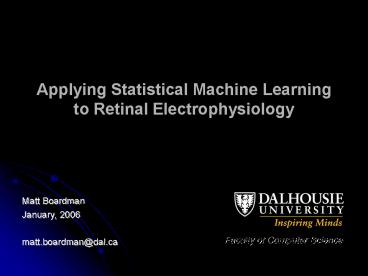Applying Statistical Machine Learning to Retinal Electrophysiology - PowerPoint PPT Presentation
1 / 26
Title:
Applying Statistical Machine Learning to Retinal Electrophysiology
Description:
Classification using Support Vector Machines (SVM) Assessing ... Selection of best gamma (?) and cost (c) values obtained by exhaustive search of loge-space ... – PowerPoint PPT presentation
Number of Views:26
Avg rating:3.0/5.0
Title: Applying Statistical Machine Learning to Retinal Electrophysiology
1
Applying Statistical Machine Learning to Retinal
Electrophysiology
- Matt Boardman
- January, 2006
- matt.boardman_at_dal.ca
2
Discussions
- Axotomy ERG Data Sets
- Classification using Support Vector Machines
(SVM) - Assessing Waveform Significance
- Probability Density Estimation
- Confidence Measures
3
Axotomy ERG Data Sets (from F. Tremblay,
Retinal Electrophysiology)
- Data Set A
- 19 axotomy subjects, 19 control subjects (total
38) - time between control axotomy?
- Multifocal ERG 145 data points (mean of all
locations) - 1000 Hz (?) sample rate
- Data Set B
- 6 axotomy subjects, 8 control subjects (total 14)
- measurements approximately six weeks after
axotomy - Multifocal ERG 14,935 data points (103
locations x 145 ms) - Corneal and Optic Nerve readings (control
subjects only)
4
Classification using Support Vector Machines
- SVM use statistical machine learning
- Constrained optimization problem
- Objective Find a hyperplane which
maximizes margin - Higher dimensional mappings provide flexibility
- Non-separable data a cost parameter controls
the tradeoff between outlier detection and
generalization performance - Non-linear SVM (Polynomial, Sigmoid, Gaussian
kernels)
5
Data Normalization
- Balanced training data
- Number of positive samples number of negative
samples - Data set A is already balanced
- Keep data set B balanced through combination,
i.e. 8C628 - Independently and identically distributed (iid)
data - Independence not true
- e.g. value of point x17 most likely depends on
x16 - Not Identically distributed
- e.g. x26 is always positive (P1 wave), but x40 is
always negative (N2 wave) - Approximate iid data by subtracting mean from
each dimension, then dividing each dimension by
its maximum magnitude - results in zero mean for all dimensions, with all
values between -1 and 1 - No zero-setting necessary!
- e.g. subtracting mean tail value does not affect
classification accuracy!
6
Parameter Selection for Classification
- Selection of best gamma (?) and cost (c) values
obtained by exhaustive search of loge-space - try all possible parameter values, choose best
points (red circles) - accuracy-weighted centre of mass gives optimal
point (green circle) - Training / Testing
- 75 / 25
- Leave one out
- Better searches
- 3 strikes
- Simulated annealing (?)
7
Classification Results
- Data set A (38 samples x 145 data points)
- 94.7
- Data set B (14 samples x 145 data points)
- 99.4
- Data set B (14 samples x 14,935 data points)
- 90.8
8
Classification Benchmarks
- How does this method perform on industry-standard
classification benchmark data sets? - Wisconsin Breast Cancer Database
- O.L. Mangasarian, W.H. Wolberg, Cancer diagnosis
via linear programming, SIAM News,
23(5)1-18, 1990. - Iris Plants Database
- R.A. Fisher, The use of multiple measurements in
taxonomic problems, Annual Eugenics,
7(2)179-88, 1936.
9
Classification Benchmarks
Wisconsin 96.9, s0.18
Iris (Class 1 or not) 100.0
Iris (Class 2 or not) 96.9, s0.55
Iris (Class 3 or not) 97.1, s0.77
10
Assessing Waveform Significance
- Which are the most important parts of the
waveform, with respect to classification
accuracy? - Fisher Ratio
- distance between means over sum of variance
(linear) - Pearson Correlation Coefficients
- strength of association between variables
(linear) - Kolmogorov-Smirnoff
- distance between cumulative distributions
(non-linear) - Linear SVM
- classification on one dimension only (linear)
- Cross-Entropy
- mutual information measure (non-linear)
- SVM Sensitivity
- Monte Carlo simulation using SVM (non-linear)
11
Comparison of All Measures (Dataset B)
12
Probability Density Estimation
- Goal define a measure to show how sure the
classifier is with the result - Density Estimation is known to be a hard
problem - Generally need large number of samples for
accuracy - Small deviations in sample points have magnified
effect - How do we estimate a probability distribution?
- Best-Fit Gaussian
- Assume Gaussian distribution, find sigmoid that
fits best - Kernel Smoothing
- Part of MATLABs Statistics Toolbox
- SVM Density Estimation (RSDE method)
- Special case of SVM Regression
13
Comparison of Estimation Techniques
14
Confidence Measures
- Support is the overall distribution of the
sample - Denote p(x)
- Density H p(x) dx 1
- Confidence is defined as the posterior
probability - Probability that sample x is of class C
- Denote p(Cx)
- Can we combine these measures somehow?
15
Confidence Measures
16
Confidence Measures
17
Confidence Measures
18
References
- SVM Tutorial (mathematical but practical)
- C. Burges, A Tutorial on Support Vector Machines
for Pattern Recognition, Data Mining and
Knowledge Discovery, 2(2)121-67, 1998. - SVM Density Estimation (RSDE algorithm)
- Mark Girolami, Chao He, Probability Density
Estimation from Optimally Condensed Data
Samples, IEEE Trans. Pattern Analysis and
Machine Intelligence, 25(10)1253-64, 2003. - MATLAB versions
- LIBSVM http//www.csie.ntu.edu.tw/cjlin/libsvm
- SVMlight http//svmlight.joachims.org/
- An excellent online SVM demo (Java applet)
- http//www.csie.ntu.edu.tw/cjlin/libsvm/GUI
19
Data Representation
- We can represent the input data in many ways
- Unprocessed vector (145 dimensions as is)
- Second order information (first time derivative)
- Third order information (second time derivative)
- Frequency information (Power Spectral Density)
- Wavelet transforms (Daubechies, Symlet)
- Result Only small differences in accuracy!
20
Data Representation
- Example Wavelet representations
- i.e. some indications, but nothing statistically
significant (5)
21
Cross Entropy
22
SVM Sensitivity Analysis
23
SVM Sensitivity Analysis (Windowed)
24
Comparison of Estimation Techniques
25
Comparison of Estimation Techniques
26
Comparison of Estimation Techniques































